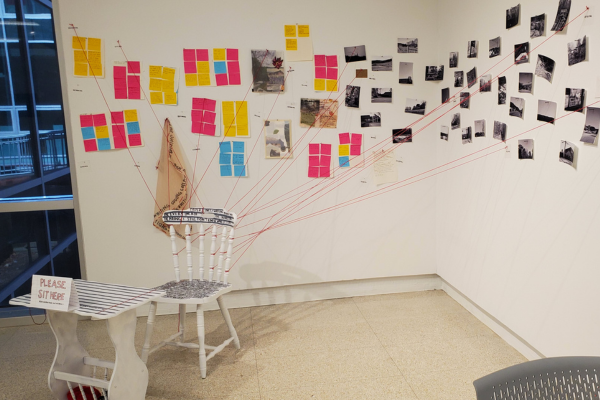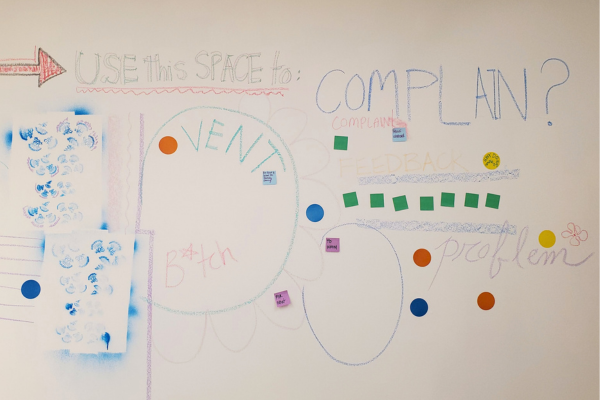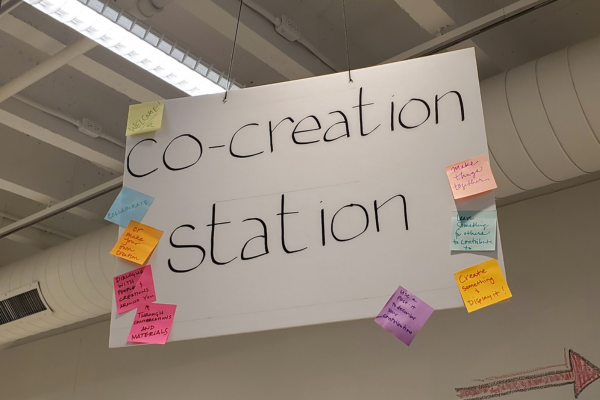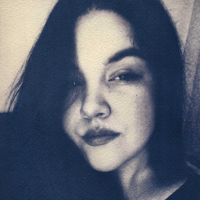A Journey in Collaboration and Research: The “trace layer play collective” on Their Interactive Exhibition in Hopkins Hall Gallery

Upon entering Hopkins Hall Gallery, one will immediately sense the vibrant energy emanating from the transformed space. The 2024 exhibition by the trace layer play collective beckons visitors to engage actively—touch, listen, create, self-reflect, and even complain.
Established in 2020, this collective is composed of graduate students and alumni from the Department of Arts Administration, Education, and Policy at The Ohio State University, united in their collaborative approach to arts-grounded research and their exploration of interactive exhibitions.
Over the course of its lifetime in Hopkins Hall, the exhibition will evolve into a dynamic space where ideas come alive, fostering a sense of community among guests and researchers alike. The Co-creation Station, an inviting centerpiece upon entering the gallery, encourages willing participants to flex their creative muscles and contribute to the evolving space. In trace layer play, every visitor has the opportunity to use their voice and to imprint their presence on the exhibition.
Urban Arts Space spoke with trace layer play members Erin Hoppe, Noor Murteza, Polly Isurin, Aelim Kim, Tamryn McDermott, Amy Holihan, Nupur Sachdeva, and Robin Gordon. In this exclusive interview, the members reflect on the intricate process of preparing for this exhibition and share their aspirations for the journey that awaits attendees in the 2024 exhibit.
trace layer play is now open in Hopkins Hall Gallery from Monday, February 19 to Friday, March 1. The Re-play closing event takes place on March 1 from 4:00 to 5:00 p.m., and the event will be livestreamed here. Read more from the trace layer play collective on their website.

What has been your primary project in the exhibition?
Noor: I invite participants to write with chalk on the walls of the gallery space. I present this activity to others as a venting and complaining opportunity. Ask any graduate student and they will confirm that a big part of the process of research as a graduate student is to grumble, whine, cavil, whinge, moan—that is to say that group complaining is an important social activity and bonding exercise.
Robin: This year, the Co-creation Station returns, inviting public participants to engage in arts-based dialogue through arts-based practices and materials. Also in the space this year is Researcher Exposed/Researcher Obscured, an invitation to explore the ways in which we strive to communicate our research experiences to others and ourselves.
For you, what are the benefits to exploring the intersections of art and research?
Polly: I view art as a form of research. While "traditional" research forms can sometimes feel that they only reach a limited audience, art is able to speak to a wider and more diverse range of people. Pushing the boundaries of what constitutes research, while expanding notions of art's capabilities, consistently pushes me out of my comfort zones and invites new interpretations and insights into how to experience and understand the world.
Amy: I am a ballet dancer by training, so I feel I have been exploring this intersection my whole life through this work. They feel intrinsically connected to me, as creating art is an experimental process for asking and exploring big questions. I feel I can approach big ideas and my own curiosity best through art-making; it leaves space for me to make mistakes, discover the unexpected, and visually piece together puzzles.

What role does collaboration play in your creative research process?
Amy: It's essential!
Erin: My dissertation asked people to reflect, walk, and create. The entire approach—an arts-based inquiry—would not have been possible without embracing creativity and collaboration at every stage of the research process: design, implementation, analysis, and presentation. Collaboration meant I had to give as much of myself as I asked of research participants; there was a vulnerability necessary for everyone involved.
Tamryn: I am interested in how multiple perspectives can shape the research process. When we come together as a collective, we achieve so much more than any of us could have imagined. Bringing the public into our in-process research provides valuable learning opportunities and gives us the space to experiment and try things out in a low stakes and supportive environment.

What or who have you looked to for inspiration?
Aelim: My colleagues in trace layer play have inspired me within the AAEP community. Through non-hierarchical interactions, my PhD journey has been enriched by the diverse backgrounds and skills of these friends. They are different backgrounds from me, bringing diverse skills and knowledge to trace layer play activities. They have been my good mentors as well. Also, the research and artistic practices of the faculty members in AAEP always give me new ideas, stimulating my curiosity.
Nupur: I have reflected inwards for inspiration. As a South Asian woman currently residing in the US with proficiency in multiple languages, I often encounter challenges in translating my academic thoughts into English. This continuous need for translation has gradually limited my ability to think in languages other than English. My Hindi thought processes now seamlessly merge into Hinglish or English. I am intrigued by the impact of constant translation into English on texts and artistic expression to understand ways in which we can decolonize art educational spaces.
Are there any moments of personal joy from the journey of creating this exhibition that you’d like to share?
Nupur: Yes, setting it up and seeing it come to life with people enjoying clay-play through the engagement prompts was just beautiful!!
Noor: The moments of joy and play that we are able to inject into the research process and the long schlep of a PhD program are a highlight of my experience in co-founding the trace layer play collective.
Aelim: I consistently find pleasure in our routine meetings throughout the preparation phase. Coming from South Korea, I've rarely encountered such collaborative dynamics in both higher education and K-12 settings. Meeting exceptional colleagues and receiving their emotional support has been invaluable to me. Experiencing the collaborative process within a collective and having a sense of belonging brings me genuine joy.

What would you like visitors to take away from their experience of trace layer play?
Erin: The "world" takes research very seriously, and it is a serious business, but that doesn't mean it can't be playful. Research can feel lonely, struggling to find the right words to write late into the night. But research is, at its heart and soul, a collaborative journey.
Noor: Learn to make your processes sustainable by injecting play and joy and by surrounding yourself with community.
Polly: Often research is only shared or discussed in its final forms, and rarely is outside opinion and dialogue incorporated into the research process. trace layer play works against these traditions. We gain just as much as our visitors from the exhibition, because we approach it as a collaborative endeavor, a creative process, and an ever growing and evolving experience.
Aelim: I hope our visitors will delve into profound thinking processes and immerse themselves fully. Additionally, I wish for them to explore various research interests with diverse methodologies and different ways of presenting and communicating the findings.
Tamryn: I hope visitors leave feeling like they were a part of something, had a voice, and were able to contribute to the exhibition. I also hope that they gain an appreciation and deeper understanding of the value of the arts in research and in their own lives.
Amy: I hope people leave with an itch to play and make art! To (re)discover ways to think about complex questions—to sit with them in exploration.
Nupur: If a visitor walks away “just being curious” about any/all things they engaged with in the space, I think that's a win for arts-based research!
Robin: Research doesn't always have to be lonely. Befriending messiness can be incredibly liberating. Play might be the key to human sustainability.

